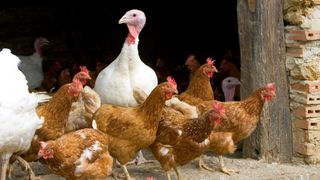H5N1 bird flu strain strikes 1st person in US
The case was detected in an inmate of a Colorado state prison.

An inmate of a Colorado state prison has become the first person in the U.S. to test positive for a strain of H5N1 bird flu that's currently spreading in birds around the world.
The man, a prisoner at a state correctional facility in Delta County in western Colorado, tested positive with H5N1 flu after handling infected poultry at a farm in nearby Montrose County, the Colorado Department of Public Health and Environment announced on Thursday (April 28). The man is isolating while being treated with the influenza antiviral drug oseltamivir. The risk posed to the public is low given that this virus does not usually infect humans or spread between people, according to the department.
H5N1 is a highly pathogenic strain of avian influenza (HPAI), or bird flu, which infects both poultry, such as chickens and turkeys, as well as free-flying waterfowl such as ducks, geese and shorebirds. Since its first detection in wild bird populations in North Carolina and South Carolina in January and a later detection in a flock of Indiana turkeys in February, the disease has spread to an estimated 35 million domestic birds in 29 states, causing farmers to cull more than 24 million birds in a desperate attempt to stop the spread, according to US Department of Agriculture (USDA) estimates.
Related: Going viral: 6 new findings about viruses
The prisoner, who is under 40 and had been culling infected poultry at the commercial farm as part of a correctional pre-release employment program, showed only mild symptoms of fatigue and has since recovered. The flock that infected him was euthanized.
"This is the second human case associated with this specific group of H5 viruses that are currently predominant, and the first case in the United States," Centers for Disease Control and Prevention (CDC) officials wrote in a statement.
The first international case of this H5N1 strain occurred in December 2021 in the United Kingdom when the 79-year-old Alan Gosling, who lived with 20 pet ducks inside his home in Devon, England, tested positive for the disease, Live Science previously reported.
Sign up for the Live Science daily newsletter now
Get the world’s most fascinating discoveries delivered straight to your inbox.
Last detected in the U.S. in 2020, bird flu tends to arrive with the spring migrations of wild birds, which fall between March to May each year. While wild birds, such as ducks and geese, usually experience only mild symptoms, farmed chickens and turkeys are much more susceptible to severe disease.
H5 viruses are of concern to scientists not only because of the economic damage they inflict upon the poultry industry, but because they have the potential to spread to humans. Infections jump from infected birds to people when they have had "close or lengthy unprotected contact with infected birds or places that sick birds or their mucous, saliva, or feces have touched," the CDC wrote in the statement.
Once in humans, H5N1 can cause severe respiratory illness, including pneumonia and respiratory failure, which can lead to death.
Over 800 people worldwide have been infected with earlier versions of H5N1 bird flu that circulated previously, but the current circulating strain is different from earlier versions, according to the CDC.
The mortality rate for H5N1, taken from the roughly 860 people previously recorded to have been infected with the strain, is around 60%, according to the World Health Organization (WHO). And although human-to-human transmission of avian flu is rare, scientists have warned governments that outbreaks must be mitigated before a virus strain evolves to spread among humans, potentially giving rise to a pandemic.
"The ongoing 2021–2022 wave of avian influenza H5N1 is unprecedented in its rapid spread and extremely high frequency of outbreaks in poultry and wild birds, and is a continuing potential threat to humans," Michelle Wille and Ian Barr, researchers at The Peter Doherty Institute for Infection and Immunity in Melbourne, Australia who study the risks of bird flu to humans, said in a statement.
The CDC has said that, while the infected man's positive test result meets the criteria for an H5 case, there could be a possibility he might not have been infected. The test result may have instead picked up a trace of the virus on the surface of his nasal membrane. However, the CDC said that "the appropriate public health response at this time is to assume this is an infection and take actions to contain and treat."
The continuing spread of the disease and the culling of millions of commercial birds has put meat and eggs in much tighter supply. The average price of a dozen eggs has nearly doubled to $2.60 from last year's price of $1.40, according to the USDA.
The Colorado Department of Public Health said that it is still safe to eat poultry and poultry products, provided that they have been properly handled and cooked.
"The proper handling and cooking of poultry and eggs to an internal temperature of 165 degrees Fahrenheit (74 degrees Celsius) kills bacteria and viruses, including H5N1 viruses," Department officials said in a statement.
Originally published on Live Science.

Ben Turner is a U.K. based staff writer at Live Science. He covers physics and astronomy, among other topics like tech and climate change. He graduated from University College London with a degree in particle physics before training as a journalist. When he's not writing, Ben enjoys reading literature, playing the guitar and embarrassing himself with chess.
